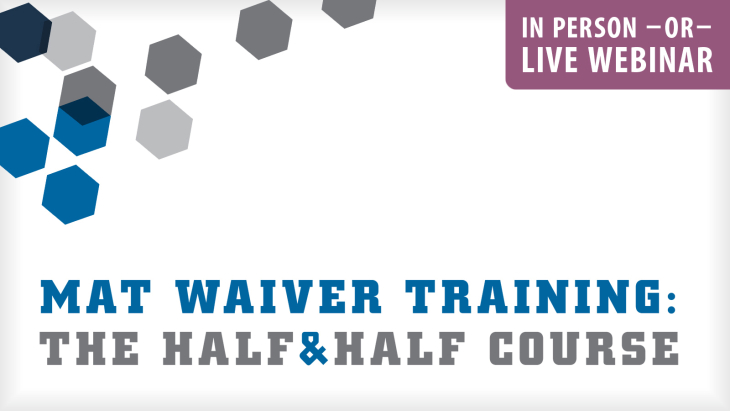
Location
Dates & Times
Contact
Do you have event related questions or need help with registration?
Opioid use disorder is an epidemic in the United States. While progress has been made in training providers, the gap in providing effective treatment of opioid use disorders continues to widen—moving beyond heroin addicted individuals to a much larger and diverse segment of the population. This increase is predominantly due to an alarming increase in addiction to prescription opioid analgesic medications. Buprenorphine, the most recent addition to the pharmacotherapies available to treat opioid use disorders, is novel among the opioid pharmacotherapies because of its partial agonist properties. It has been placed on Schedule III and is available by prescription from a physician's office-based practice.
Recognizing the impact of this addiction, as well as learning how to treat opioid use disorders, are important steps in combating this ever growing medical problem. To obtain the waiver to prescribe, providers are required to take specialized training. PCSS-MAT uses the Half-and-Half format (first, 4.00 hours of face-to-face training with an instructor, followed by 4.00 hours of on-your-own-training that must be completed along with a post test). This meets the training requirements for physicians; however, additional training is required for advanced practice providers. The training focuses on the specifics of treating patients with opioid use disorders in office-based settings and clinical vignettes to help trainees think through "real life" experiences in opioid use disorders treatment. Once the waiver training is completed in full, participants will receive a CME certificate of attendance from AAAP.
This program was designed to satisfy, in part, the North Carolina Medical Board's CME requirement for controlled substance prescribers. Per NCAC rules: As of July 1, 2017 all physicians (other than residents), physician assistants, nurse practitioners, podiatrists, and dentists who prescribe controlled substances must satisfy the controlled-substance prescribing CE requirements as set forth by their licensing boards; requirements vary by discipline and board.
Method of physician participation in the learning process: 4.00 hours of CE credit will be awarded by MAHEC for completing the "first half" of the training. AAAP will award 4.0 hours of CE credit for the "second half" of the training. To be awarded a maximum of 8.00 AMA PRA Category 1 Credits™ and a Buprenorphine Training Completion Certificate you must complete both parts of this training and receive a minimum cumulative score of 75% on the examination. No partial credit is awarded for the online portion of this training. If you do not complete both parts of this training, you will not be eligible to receive a Buprenorphine Training Completion Certificate and will need to take the training again.
By registering for this workshop, you are granting permission for your contact information to be shared with DHHS which is a collaborating partner of this continuing education activity.
MAHEC engages in evaluation activities to better understand the impact of our programs. By registering for this course, you agree that we may use your personal information in evaluative research regarding this program. Any reports published will be de-identified and reported in aggregate format.
MAHEC assumes permission to use audio, video, and still images from this program for promotional and educational purposes. Please speak with a staff member if you have any concerns.
Funding for this initiative was made possible (in part) by grant no. 1H79TI081968-01 from SAMHSA. The views expressed in written conference materials or publications and by speakers and moderators do not necessarily reflect the official policies of the Department of Health and Human Services; nor does mention of trade names, commercial practices, or organizations imply endorsement by the U.S. Government.
This document is supported by funds from the North Carolina Department of Health and Human Services through the Centers for Disease Control and Prevention (CDC) Cooperative Agreement Number NU17CE92024.
